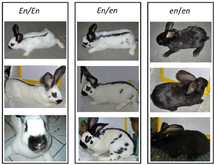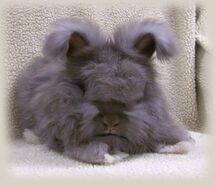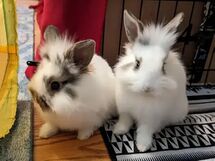Prior to domestication, rabbits were all of the agouti or wild-type color pattern, characterized by alternating bands of black and red color on the hair shaft.
Major coat color genes
Most of the genes that affect coat colors on rabbits are located on four pairs of chromosomes. These genes have been categorized into a system referred to as the coat color series and are labeled A to E (agouti, brown, color, dilution, and extension).[1]
A series: Agouti
| Genes |
Colors
|
| A |
Agouti
|
| at |
Tan
|
| a |
Non-agouti
|
B series: Brown
| Genes |
Colors
|
| B |
Agouti
|
| b |
Brown or chocolate
|
C series: Color
| Genes |
Colors
|
| C |
Agouti
|
| cchd |
Dark chinchilla
|
| cchm |
Medium chinchilla
|
| cchl |
Light chinchilla
|
| ch |
Himalayan
|
| c |
Albino
|
D series: Dilution
| Genes |
Colors
|
| D |
Agouti
|
| d |
Blue dilution
|
E series: Extension
| Genes |
Colors
|
| Ed |
Black agouti
|
| Es |
Steel agouti
|
| E |
Agouti
|
| ej |
Japanese brindling
|
| e |
Red or yellow
|
Coat pattern genes
Other genes other than the major A to E coat color series exist that also exert pronounced effects on the coat color pattern.
Du series: Dutch
| Genes |
Colors
|
| Du |
Normal
|
| Dud |
Dark Dutch, minimal spotting
|
| duw |
White Dutch, excessive spotting
|

The Hotot pattern is made from a mix of En and Du genes. Source:
Amy Hinkle, M.S. [PDF]
En series: Broken

A diagram of the En gene phenotypes in the Checkered Giant breed.
| Genes |
Colors
|
| En |
English spotting
|
| en |
Normal
|
Charlies have two En/En genes, normal broken rabbits have En/en genes, while normal solid colored rabbits have en/en genes.
si series: Silver
| Genes |
Colors
|
| Si |
Normal
|
| si |
Silver coat surface
|
v series: Vienna

A litter of rabbits with the Vienna gene mixed in.
| Genes |
Colors
|
| V |
Normal
|
| v |
White coat, blue eyes
|
w series: Wide band
| Genes |
Colors
|
| W |
Normal agouti band
|
| w |
Wide agouti band
|
Coat structural genes
f series: Furless locus
| Genes |
Colors
|
| F |
Normal
|
| f |
Furless
|
l series: Angora locus

A chocolate English Angora.
| Genes |
Colors
|
| L |
Normal
|
| l |
Hair long, wool
|
m series: Mane locus
| Genes |
Colors
|
| M |
Hair long around the head, ears, chest, and flank
|
| m |
Normal
|
r series: Rex locus

A blue tort plush lop with Rex fur.
| Genes |
Colors
|
| R |
Normal
|
| r |
Hair short, rex
|
sa series: Satin locus
| Genes |
Colors
|
| Sa |
Normal
|
| sa |
Hair thin, satin
|
wa series: Waved locus
| Genes |
Colors
|
| Wa |
Normal
|
| wa |
Hair waved, astrex
|
Further reading
- Green Bean Farm, Identifying Coat Colors and Associated Genetic Information
- American Rabbit Breeders Association, Eric Stewart, Rabbit Color Genetics
- Mosaic's Rabbitry, Rabbit Coat Color Genetics
- Jills Wild Dutch Bunch, Color Comparison Chart
- Rexivous Rabbitry, Color Genotype
- The Nature Trail
- Rabbit Color Genetics Information: The A-series. Agouti, Tan Pattern, and Self.
- Rabbit Color Genetics "B" Series: Black and Chocolate Genes
- Color Genetics: The C Series. Full Color, Chinchilla, Sable, Himalayan or Pointed White, and REW
- Dilute and Dense Rabbit Color Genetics - D Series, or Blue and Black
- Rabbit Coat Color Genetics - Extension, Steel, and Tri-color at the E locus
- Rabbit Color Genetics:The Pattern Gene EN for Brokens, Solids, and Charlies
- Chart of 144 Rabbit Coat Colors And Their Genotypes
- Mink Hollow Farm, An Illustrated Guide to Rabbit Coat Colour Genetics
- Amy's Rabbit Ranch, Amy Hinkle, Rabbit Genes
- Ringenbach Rabbitry, Genetic Color Calculator
See also
References
- ↑ Lukefahr, Rabbit Production, 9th ed, 2013.








